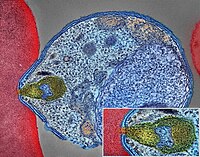
Photo from wikipedia
Background Individuals with metabolic syndrome are five times more susceptible to chronic diseases. Assessment of its magnitude, components, and risk factors is essentials to deploy visible interventions needed to avoid… Click to show full abstract
Background Individuals with metabolic syndrome are five times more susceptible to chronic diseases. Assessment of its magnitude, components, and risk factors is essentials to deploy visible interventions needed to avoid further complications. The study aimed to assess magnitude, components, and predictors of metabolic syndrome in Tigray region northern Ethiopia, 2016. Methods Data were reviewed from Tigray region NCDs STEPs survey data base between May to June 2016. A total of 1476 adults aged 18–64 years were enrolled for the study. Multi-variable regression analysis was performed to estimate the net effect of size to risk factors associated with metabolic syndrome. Statistical significance was declared at p-value of ≤0.05 at 95% confidence interval (CI) for an adjusted odds ratio (AOR). Results The study revealed that unadjusted and adjusted prevalence rate of Metabolic Syndrome (MetS) were (CPR = 33.79%; 95%CI: 31.29%–36.36%) and (APR = 34.2%; 95% CI: 30.31%–38.06%) respectively. The most prevalent MetS component was low HDL concentration (CPR = 70.91%; 95%CI: 68.47%–73.27%) and (APR = 70.61; 95%CI; 67.17–74.05). While; high fasting blood glucose (CPR = 20.01% (95%CI: 18.03–22.12) and (APR = 21.72; 95%CI; 18.41–25.03) was the least ones. Eating vegetables four days a week, (AOR = 3.69, 95%CI; 1.33–10.22), a salt sauce added in the food some times (AOR = 5.06, 95%CI; 2.07–12.34), overweight (AOR = 24.28, 95%CI; 10.08–58.47] and obesity (AOR = 38.81; 12.20–111.04) had strong association with MetS. Conclusion The magnitude of metabolic syndrome was found to be close to the national estimate. Community awareness on life style modification based on identified MetS components and risk factors is needed to avoid further complications.
Journal Title: PLoS ONE
Year Published: 2021
Link to full text (if available)
Share on Social Media: Sign Up to like & get
recommendations!